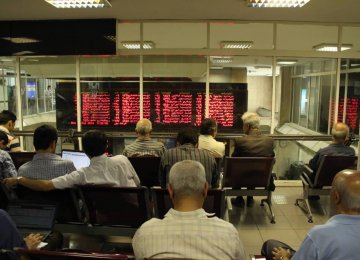A couple of years ago, there was fear of damage to the global economy from rising commodity prices.
Apart from a brief but sharp plunge in 2008, when the world seemed to be falling apart, higher commodity prices were considered the new normal. Not anymore.
Today, commodities are so cheap, producers are practically giving them for free. Commodity producing companies are cutting costs and laying off workers. Governments that relied on the sale of their natural resources are introducing deep budget cuts.
Iran, as the world’s second richest country in terms of natural resources, is going through the same, and then some more. Its situation is an amalgamation of good and bad news.
The drop in oil revenues has battered the bulk of its public companies, not to mention the plunge in the rest of the commodity classes. Tighter fiscal spending, along with poor corporate performance, is threatening recovery. Yet, the promise of rolling back sanctions and the dollar’s rise throws some life into the mix.
Tehran Stock Exchange’s main index is hovering above 26-month lows. TEDPIX rose 0.53% to a nine-day high of 62,055.90 points on Tuesday. But “fundamental global and domestic factors have made TSE’s recovery uncertain”, our sister publication Tejarat Farda wrote last week.
The Good News, Sort of!
Sanctions that led to a 70% devaluation of its currency and two years of back-to-back slides in economic output—GDP contracted 6.6 % and 1.9 % in 2012 and 2013, respectively—are soon to be rolled back. Iranian officials expect it to happen early 2016.
The removal of sanctions comes in exchange for curbs on Tehran’s nuclear program. All of this is part of the historic accord reached between Tehran and the P5+1—Britain, China, France, Germany, Russia and the United States—in July 2015.
The lifting of sanctions will first and foremost see the ban on dealing with the Central Bank of Iran and many Iranian banks removed. Normal banking relations are estimated by economists to reduce commercial costs by nearly 30%. This will, in turn, boost exports and raise profit margins.
Investment in Iran, first in liquid equities and bonds and later, directly, will surge. Iran’s 80 million young and educated population provides ample opportunities for growth. Its market has largely remained untapped.
Sanctions started turning away foreign companies a decade ago. Now things are changing.
Foreign investment and growth in non-petroleum sectors are considered “the drivers of growth in the years to come”, by president’s senior economic advisor, Masoud Nili.
Caps on Iran’s oil sales will also be removed. Meaning Iran can ramp up production and regain market share lost to sanctions. But that would add to the massive glut in global crude supplies.
Raising Crude Output
However, Iran’s Oil Ministry is signaling prudence. A rise in Iran’s crude oil exports, once sanctions against it are lifted, depends on future global demand and should not further weaken oil prices, senior officials were quoted as saying, Reuters reported.
Oil Minister Bijan Namdar Zanganeh said Iran did not plan to exacerbate an already bearish oil market on Monday.
“We are not seeking to distort the market but will regain our market share,” said Zanganeh, quoted by the Oil Ministry’s news agency Shana.
Iran has repeatedly said it plans to raise oil output by 500,000 barrels per day post-sanctions, and another 500,000 bpd shortly after that, to reclaim its position as the Organization of Petroleum Exporting Countries’ second-largest producer.
“The decision on the amount of exports highly depends on the future condition of the market. We will raise our market quota steadily,” said Mohsen Qamsari, National Iranian Oil Company’s director for international affairs.
Commodities’ Worst Year
Oil and commodities were the world’s worst-performing asset class for the second year running in 2015, pressured by China’s economic slowdown and excess supply.
Brent crude lost around 36% for the year, as sustained selling pushed prices near 11-year lows and the outlook for oil prices looks bleak for 2016.
The supply side continues to be dominated by producers’ unwillingness to cut output, which has led to a surplus of hundreds of thousands of barrels of crude every day as well as a price drop by two-thirds since mid-2014.
ANZ said the recent tensions between Saudi Arabia and Iran “will further aggravate the oversupply situation in 2016”.
The Thomson Reuters CRB commodities index fell 24% to six-year lows.
Iranian companies have felt the pain. Over 40% of listed equities have a foot in petroleum. Crude’s drop has eroded the price of their end product and with it their earnings. The lifting of sanctions will only help cushion the damage.
As a result of weaker demand for their goods, TSE’s petroleum producers’ index has lost 57% since mid-2014, when oil’s plunge started, based on data compiled by Tejarat-e Farda.
Chemical producers, on the other hand, have lost 13%. Comparatively, crude prices have plunged by two-thirds since mid-2014 as soaring output led to a global surplus of between half a million and 2 million barrels per day.
Iran also has two heavyweights producing iron ore, some steel manufacturers and many metal processing companies, including copper and zinc producers.
TSE’s Base Metals Index has retreated 41% while its Metal Ore Extraction Index has lost 45% since mid-2014.
Dollar and Poorly Run Companies
The prospect of the removal of sanctions coupled with declining crude sales has sent the rial scurrying away from its optimistic valuations in July to two-year lows against the dollar.
Moreover, the US Federal Reserve began raising interest rates for the first time in nearly a decade late last year, further strengthening it against all major currencies.
The greenback has gained over 12% against the rial since the signing of the nuclear accord in July. The US currency edged down 0.05% to 36,760 rials by 1224 GMT on Tuesday, slightly off a two-year high.
Greenback’s rise will reduce the damage from falling commodity prices. It very well may turn Iranian companies profitable once more.
A study of 41 TSE-listed companies by our sister publication, Donya-e-Eqtesad newspaper, showed that if dollar trades around 37,000 rials in the next Iranian fiscal year (starting March 20, 2016), corporate profits will surge 24%.
The study did not account for the effect of weakening commodity prices and other major geopolitical and economic changes, however.
Will the dollar’s rise and the lifting of sanctions outweigh fragile commodity prices and help the TSE and Iranian companies wake up from a two-year slumber remains to be seen. But let us not forget that a large part of the poor corporate earnings lies in their appalling productivity. Not to mention an ongoing crisis of toxic debt in banks, which has frozen the lending market and left banks out of breath.
The list of structural faults in Iran’s economy borders on the infinite. These faults will continue to hamper earnings.






